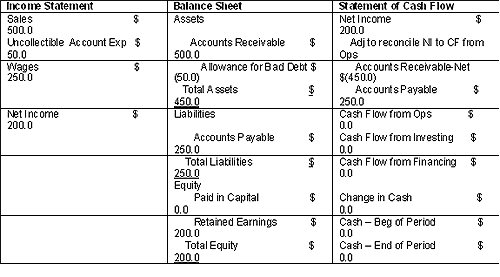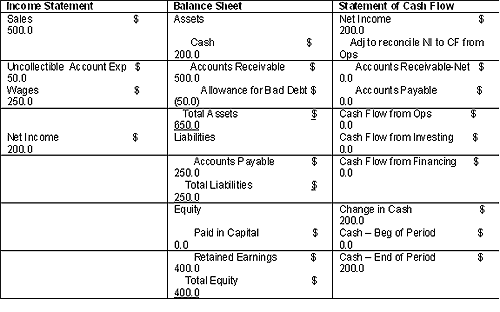By Tim Keefe ,CFA (Contact Author | Biography)
As was noted earlier, earnings management is predominantly a function of manipulating accruals, so it is intuitive to use the magnitude of accruals as a proxy for earnings quality: the higher the total accruals as a percentage of assets, the greater the likelihood that earnings quality is low. Remember that accruals can be either a reflection of earnings manipulation or just normal accounting estimations based on future business expectations. It is difficult to determine which one is driving the accruals, but there is evidence that the size of accruals can be used as a rough measure for earnings manipulation, especially in high-accrual firms.
In order to measure the total net accruals created in a given period, you need to take the reported earnings produced with accrual accounting during the period and subtract the cash earnings during the period. There are two ways to get this done: you can use the either the balance sheet or the cash-flow statement to pull out the total net accruals buried in the reported earnings amount. (For more insight, read Advanced Financial Statements Analysis.)
The Balance Sheet Method
Using the balance sheet, we can find the total net accruals by subtracting:
But the balance sheet doesn't directly tell us what accrual earnings or cash earnings were in the period, so we will have to perform further calculations to retrieve this information.
Calculating Accrual Earnings
Recall that net income flows into the balance sheet as retained earnings, which can be found in the owners' equity (net worth) section of the balance sheet. Owners' equity also reflects net distributions to equity holders, and we will need to make some adjustments for these items. So, owners' equity at the end of the period will be:
To calculate accrual earnings, we can rearrange the equation above and find that it is the difference between ending owners' equity and beginning owners' equity, adjusted for dividends, stock repurchases and stock issuances. This adjustment can be summarized as net cash distributions to equity.
Now, assuming that Assets - Liabilities = Owners' Equity, we can substitute in to get the following equation for accrual earnings:
Calculating Cash Earnings
To begin, cash earnings must be somehow related to the cash account and can be found by looking at the change in the cash account. Remember that the cash account also is affected by net cash distributions to equity holders, and we will need to make some adjustments for these items. So, cash earnings at the end of the period will be:
Calculating Total Net Accruals
The section began with the basic total net accruals equation and then went on to define accrual earnings and cash earnings. Now with these definitions in hand, we can substitute them in.
The net cash distributions to equity cancel each other out, and the equation reduces to:
The Statement of Cash Flow Method
Using the statement of cash flow, we can find total net accruals with same the basic equation as before:
Calculating total net accruals from the statement of cash flow is a bit more straightforward. This is because we don't need to pull out accrual earnings, because net income is stated right on the report.
Calculating Accrual Earnings
Calculating Cash Earnings
Calculating Total Net Accruals
The Accrual Equations In Action
Let's run through the water-service example given in Chapter 2 of this tutorial to see how all the equations work as the transactions occur. In this example, you hired someone to draw water from the public well and carry it to 10 of your neighbors for $50 a day. Your neighbors pay you $10 a day each for the service - a $100 total per day. Everyone agrees that payday will be on Friday night, and that no cash will change hands until then. You expect that one of your neighbors, Joe, will fail to pay you for your services. This business requires no capital to start and the balance sheet states Cash = $0, Total Assets = $0, Total Liabilities = $0, and Equity = $0.
Now, using the total net accrual equation, on Friday afternoon we can find the net accruals for the Friday-to-Friday period:
Balance Sheet Approach
Statement of Cash Flow Approach
On Friday night, nine of you neighbors pay you $50 each, but Joe (as you expected) refuses to pay. You pay your employee $250, and put $200 in savings. The next week, you do it all over again.
Now, using the total net accrual equation, on Friday afternoon we can find the net accruals for the Friday-to-Friday period:
Balance Sheet Approach
Statement of Cash Flow Approach
On Saturday morning, you go to the office with another $200 and some accounting that needs to be completed. Your employee has quit and you can't find a replacement, so you close shop. At the end of the day, things look like this:
Now, using the total net accrual equation, on Saturday we can find the net accruals for the one-day period:
Balance Sheet Approach
Statement of Cash Flow Approach
Theoretically, as demonstrated with the simple example above, measuring total net accruals with either the balance sheet or the statement of cash flow approach results in the same accrual amount. But practically speaking, using the balance sheet is more difficult because there are events that affect cash but not retained earnings or affect retained earnings but not accrual earnings. In effect, not all the data needed is on the balance sheet, and you have to go searching through the other financial statements to find what you need.
For example, if a firm has cash holdings in a foreign country, the currency translation back into the home currency will change the cash balance due to fluctuating exchange rates even if the actual cash amount in the foreign bank never changes. Because a positive change in cash reduces net accruals, a declining home currency makes it appear that accruals are lower. The analyst needs to look at the bottom of the statement of cash flow to find the effects of exchange rates on cash and adjust the accrual amount accordingly.
Evaluating Accruals In Context
Briefly, both the size of the firm and its life stage relative to its industry peers should have an impact on the amount of accruals. As you can see from the above example, a growing company will reasonably have $200 in total net accruals while a mature company will have $0. The difference in total net accruals between these two firms does not mean the growing company has low-quality earnings.
It is important to note that in Week 1, the startup business was growing, and the total net accruals were $200. In Week 2, the business was already ramped up and mature, and the total net accruals were $0. Finally, in Week 3, the business was winding down, and the total net accruals were negative $200. Also note that you used impeccable judgment when estimating the accrual accounts.
This example demonstrates how high-growth firms can generate a large amount of accruals, even without manipulation. It also highlights the fact that calculating accruals is only one part of the analysis. You need to consider non-accrual accounting information and put context to the accrual measure by comparing the company's accrual information to other companies. (For related reading, see Is Growth Always A Good Thing?)
Earnings Quality: Adjusting Accruals For Proper Comparisons
As was noted earlier, earnings management is predominantly a function of manipulating accruals, so it is intuitive to use the magnitude of accruals as a proxy for earnings quality: the higher the total accruals as a percentage of assets, the greater the likelihood that earnings quality is low. Remember that accruals can be either a reflection of earnings manipulation or just normal accounting estimations based on future business expectations. It is difficult to determine which one is driving the accruals, but there is evidence that the size of accruals can be used as a rough measure for earnings manipulation, especially in high-accrual firms.
In order to measure the total net accruals created in a given period, you need to take the reported earnings produced with accrual accounting during the period and subtract the cash earnings during the period. There are two ways to get this done: you can use the either the balance sheet or the cash-flow statement to pull out the total net accruals buried in the reported earnings amount. (For more insight, read Advanced Financial Statements Analysis.)
The Balance Sheet Method
Using the balance sheet, we can find the total net accruals by subtracting:
| Total Net Accruals = Accrual Earnings - Cash Earnings |
But the balance sheet doesn't directly tell us what accrual earnings or cash earnings were in the period, so we will have to perform further calculations to retrieve this information.
Calculating Accrual Earnings
Recall that net income flows into the balance sheet as retained earnings, which can be found in the owners' equity (net worth) section of the balance sheet. Owners' equity also reflects net distributions to equity holders, and we will need to make some adjustments for these items. So, owners' equity at the end of the period will be:
| End Equity = Start Equity + Accrual Earnings - Cash Dividends - Stock Repurchases + Equity Issuances |
To calculate accrual earnings, we can rearrange the equation above and find that it is the difference between ending owners' equity and beginning owners' equity, adjusted for dividends, stock repurchases and stock issuances. This adjustment can be summarized as net cash distributions to equity.
| Accrual Earnings = ΔOwners\' Equity + Cash Dividends + Stock Repurchases - Equity Issuance = ΔOwners\' Equity + Net Cash Distributions to Equity |
Now, assuming that Assets - Liabilities = Owners' Equity, we can substitute in to get the following equation for accrual earnings:
| Accrual Earnings = ΔAssets - ΔLiabilities + Net Cash Distributions to Equity |
Calculating Cash Earnings
To begin, cash earnings must be somehow related to the cash account and can be found by looking at the change in the cash account. Remember that the cash account also is affected by net cash distributions to equity holders, and we will need to make some adjustments for these items. So, cash earnings at the end of the period will be:
| Cash Earnings = ΔCash + Cash Dividends + Stock Repurchases - Equity Issuance = ΔCash + Net Cash Distributions to Equity |
Calculating Total Net Accruals
The section began with the basic total net accruals equation and then went on to define accrual earnings and cash earnings. Now with these definitions in hand, we can substitute them in.
| Total Net Accruals = Accrual Earnings - Cash Earnings = [ΔAssets - ΔLiabilities + Net Cash Dist. to Equity] - [ΔCash + Net Cash Dist. to Equity] |
The net cash distributions to equity cancel each other out, and the equation reduces to:
| Total Net Accruals = ΔAssets- ΔLiabilities - ΔCash |
The Statement of Cash Flow Method
Using the statement of cash flow, we can find total net accruals with same the basic equation as before:
| Total Net Accruals = Accrual Earnings - Cash Earnings |
Calculating total net accruals from the statement of cash flow is a bit more straightforward. This is because we don't need to pull out accrual earnings, because net income is stated right on the report.
Calculating Accrual Earnings
| Accrual Earnings = Net Income |
Calculating Cash Earnings
| Cash Earnings = ΔCash + Cash Dividends + Stock Repurchases - Equity Issuance |
Calculating Total Net Accruals
Total Net Accruals = Accrual Earnings - Cash Earnings = Net Income - ΔCash - Cash Dividends - Stock Repurchases + Equity Issuance |
The Accrual Equations In Action
Let's run through the water-service example given in Chapter 2 of this tutorial to see how all the equations work as the transactions occur. In this example, you hired someone to draw water from the public well and carry it to 10 of your neighbors for $50 a day. Your neighbors pay you $10 a day each for the service - a $100 total per day. Everyone agrees that payday will be on Friday night, and that no cash will change hands until then. You expect that one of your neighbors, Joe, will fail to pay you for your services. This business requires no capital to start and the balance sheet states Cash = $0, Total Assets = $0, Total Liabilities = $0, and Equity = $0.
 |
| Figure 8: The water service business at the end of he first week |
Now, using the total net accrual equation, on Friday afternoon we can find the net accruals for the Friday-to-Friday period:
Balance Sheet Approach
| Total Net Accruals= ΔAssets- ΔLiabilities - ΔCash = [$450 - $0] - [$250 - $0] - [$0 - $0] = $200 |
Statement of Cash Flow Approach
| Total Net Accruals = Net Income - ΔCash - Cash Dividends - Stock Repurchases + Equity Issuance = $200 - $0 - $0 - $0 + $0 = $200 |
On Friday night, nine of you neighbors pay you $50 each, but Joe (as you expected) refuses to pay. You pay your employee $250, and put $200 in savings. The next week, you do it all over again.
 |
| Figure 9: After your second week of business on Friday afternoon |
Now, using the total net accrual equation, on Friday afternoon we can find the net accruals for the Friday-to-Friday period:
Balance Sheet Approach
| Total Net Accruals = ΔAssets- ΔLiabilities - ΔCash = [$650 - $450] - [$250 - $250] - [$200 - $0] = $0 |
Statement of Cash Flow Approach
| Total Net Accruals = Net Income - ΔCash - Cash Dividends - Stock Repurchases + Equity Issuance = $200 - $200 - $0 - $0 + $0 = $0 |
On Saturday morning, you go to the office with another $200 and some accounting that needs to be completed. Your employee has quit and you can't find a replacement, so you close shop. At the end of the day, things look like this:
 |
| Figure 10: Saturday, after you collect money and pay wages |
Now, using the total net accrual equation, on Saturday we can find the net accruals for the one-day period:
Balance Sheet Approach
| Total Net Accruals = ΔAssets- ΔLiabilities - ΔCash = [$400 - $650] - [$0 - $250] - [$400 - $200] = -$200 |
Statement of Cash Flow Approach
| Total Net Accruals = Net Income - ΔCash - Cash Dividends - Stock Repurchases + Equity Issuance = $0 - $200 - $0 - $0 + $0 = -$200 |
Theoretically, as demonstrated with the simple example above, measuring total net accruals with either the balance sheet or the statement of cash flow approach results in the same accrual amount. But practically speaking, using the balance sheet is more difficult because there are events that affect cash but not retained earnings or affect retained earnings but not accrual earnings. In effect, not all the data needed is on the balance sheet, and you have to go searching through the other financial statements to find what you need.
For example, if a firm has cash holdings in a foreign country, the currency translation back into the home currency will change the cash balance due to fluctuating exchange rates even if the actual cash amount in the foreign bank never changes. Because a positive change in cash reduces net accruals, a declining home currency makes it appear that accruals are lower. The analyst needs to look at the bottom of the statement of cash flow to find the effects of exchange rates on cash and adjust the accrual amount accordingly.
Evaluating Accruals In Context
Briefly, both the size of the firm and its life stage relative to its industry peers should have an impact on the amount of accruals. As you can see from the above example, a growing company will reasonably have $200 in total net accruals while a mature company will have $0. The difference in total net accruals between these two firms does not mean the growing company has low-quality earnings.
It is important to note that in Week 1, the startup business was growing, and the total net accruals were $200. In Week 2, the business was already ramped up and mature, and the total net accruals were $0. Finally, in Week 3, the business was winding down, and the total net accruals were negative $200. Also note that you used impeccable judgment when estimating the accrual accounts.
This example demonstrates how high-growth firms can generate a large amount of accruals, even without manipulation. It also highlights the fact that calculating accruals is only one part of the analysis. You need to consider non-accrual accounting information and put context to the accrual measure by comparing the company's accrual information to other companies. (For related reading, see Is Growth Always A Good Thing?)
Earnings Quality: Adjusting Accruals For Proper Comparisons
Related Articles
-
 Investing
InvestingCash Flow From Operating Activities
Cash flow from operating activities is a section of the Statement of Cash Flows that is included in a company’s financial statements after the balance sheet and income statements. -
 Taxes
TaxesDeferred Tax Liability
Deferred tax liability is a tax that has been assessed or is due for the current period, but has not yet been paid. The deferral arises because of timing differences between the accrual of the ... -
 Investing
InvestingCash flow statement: Analyzing cash flow from financing activities
The financing activity in the cash flow statement measures the flow of cash between a firm and its owners and creditors. -
 Investing
InvestingEvaluating Your Personal Financial Statement
Determine your net worth by making your own cash flow statement and balance sheet. -
 Investing
InvestingBenefits of Amortizing a Premium Bond
Premium bonds are more complicated than traditional stocks, but there are powerful reasons why amortizing premium bonds is a strategy to consider.



